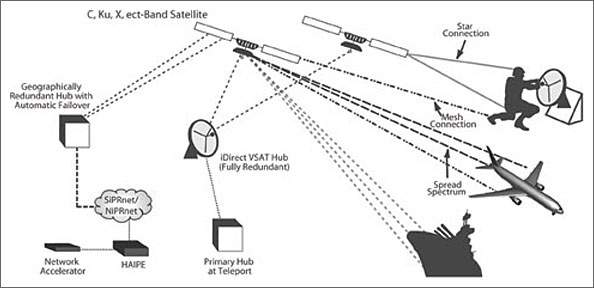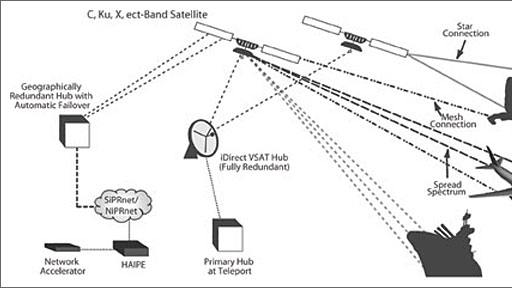A friend indeed
There is no better example of communications challenges being a matter of life or death than those faced by first responders. Quick response times, immediacy, and the ability to access real-time voice, video and data information — whether from a command center, news source or weather station — often determine the chances for success in an emergency.
Heavily damaged or destroyed terrestrial networks can put entire regions into a total communications blackout, making the work of first responders even more challenging. Even if part of the infrastructure is operational, networks quickly become overtaxed, making communications nearly impossible. To combat this, rapidly deployable satellite communications are needed to provide first responders with seamless emergency communications, rapid disaster recovery capabilities and instant continuity of operations.
Communications on the Move, or COTM, calls for broadband Internet Protocol (IP) connectivity in a mobile environment to provide instant access to information. The application of satellite communications in such environments is making an impact in the first-responder community, as well as in military and government organizations.
Mobile communications via satellite is not a new idea, but several technological advancements in the past five years have made widespread deployment more cost-effective. Smaller satellite dishes, more-effective IP technologies and the efficient use of spread-spectrum technology have fueled the growth of mobile communications via satellite.
One of COTM’s greatest advantages is having an instant network for critical communications, because first responders often are confronted with damaged cellular towers, landlines, fiber optics and other types of terrestrial infrastructure.
Besides enabling anytime, anywhere communications, COTM lets the first-responder community assess the situation at hand. First responders and public-safety agencies can receive voice, data and video transmissions from people on the ground to help evaluate the situation. This provides agencies with a situational analysis of the current events and helps agencies in dispatching extra resources as needed, and more importantly, where they are needed. It also helps agencies determine the best course of action for the safest possible outcome for all involved.
A disaster-relief operation provides the perfect example of how the first responder community can use COTM. By definition, disaster-relief operations are mobile operations. Whether the response effort involves traveling long distances in a contiguous disaster relief area or setting up new operations in a geographically remote location, field teams need to be assured that their communications system will provide seamless connectivity at any location.

While satellite enables continuous service across a wide geographic area, there are times when a relief operation must be set up outside of an organization’s satellite footprint. Additionally, there are times when a single disaster-relief effort must cover an enormous area, crossing several satellite footprints while field teams are on the move. This is where a COTM system’s connectivity and ease of use are important.
Without COTM, relief organizations can use different remote terminals to support communications in another satellite community or they can engage in the time-consuming task of reconfiguring their remote access terminals for the new service area. Either option is cumbersome, expensive and particularly difficult for non-technical field teams.
A more viable system facilitates itinerant terminals and COTM. As the term “itinerant” suggests, the remote-access terminals can move from place to place and are not bound by any particular satellite footprint. Ideally, when an operation is set up in a new satellite footprint, network operators are able to simultaneously transfer dedicated IP addresses from one satellite footprint to another satellite footprint for all of the remote access terminals that will be used to support the new operation. Importantly, the network must be able to hand off IP subnets automatically without human intervention.
COTM provides seamless connectivity literally anywhere in the world. Whether a field team is traveling by truck, ship or plane, the remote access router is intelligent enough to sense when communications are moving out of satellite range and, using automatic beam switchover, it will transfer operations to the next satellite footprint. This greatly reduces equipment needs and ensures critical communications flexibility.
A superior COTM solution facilitates high-speed IP communications via satellite that is completely independent from the terrestrial infrastructure. Any emergency team can have full communication capabilities, whether it is in a densely populated urban area where the infrastructure is damaged, or in a remote and isolated location where no infrastructure exists.
A single-hub chassis installed at the agency headquarters can support relief operations at any location and across a wide geographic footprint. From this location, network operators can configure, monitor and control all remote access sites, and even customize services to meet individual site requirements.
In the field, portable satellite routers, which weigh only 10 pounds — including the power supply — can be transported easily and deployed instantly under any conditions. Each compact satellite router includes a satellite modem and an IP router, and provides TCP optimization over satellite, QoS and prioritization, and optional AES encryption. The routers are user-friendly and reliable, enabling field teams with little or no technical expertise to easily set up and activate the system from any location.
The COTM system’s centralized management, combined with user-friendly and easily deployed satellite routers, allows response teams to quickly adapt to any emergency situation where systems and services must be transported and configured on the fly.
As a pure IP-over-satellite solution, the best COTM system delivers a complete portfolio of broadband access services over the air. Any mix of voice, data and video applications can be fully supported. Such flexibility of a COTM system to support any communications medium is important. For example, there are times when first responders need video to get a true picture of an incident while they are en route.
Let’s consider a scenario where a tractor-trailer carrying hazardous materials has been involved in a serious accident on a major highway, a visual look at the number of vehicles involved and the layout of the accident can help in knowing how many ambulances to dispatch to the site. Additionally, public-safety officials can see the hazardous container’s symbol from the video feed. This will alert them to the type of spill for which to prepare, letting them plan their response while en route, radio for special equipment needed and take other necessary actions to mitigate the situation.
COTM’s ease of deployment makes it a perfect solution for first responders who need to concentrate on what they do best — assess the situation and save lives. First responders do not require a technical background to get a COTM system working quickly. The plug-and-play satellite communications system can be set up in minutes, enabling portable communications with high bandwidth for voice, data and video telecommunications between a vehicle and headquarters.
Rapidly deployable satellite broadband is crucial, often holding the only key to mission-critical information. COTM provides the real-time secure and reliable video, data and voice transmissions that first responders, public safety, government organizations and other support entities require, delivering communications while in transit as well as at the incident site. As advancements in COTM technology keep improving communications options, it likely will be a critical component for any first-response team.
Karl Fuchs is vice president of engineering for iDirect Government Technologies.
Related Stories
- A painful lesson: Haiti suffers communications failures after earthquake
- Governance plays a big role in satellite-based disaster communications
- Satellite companies see usage surge in Haiti
- Use it or lose it: Satellite communications are most effective when they’re used for more than disaster response
- Haitian earthquake another unwanted reminder of first-response needs
















